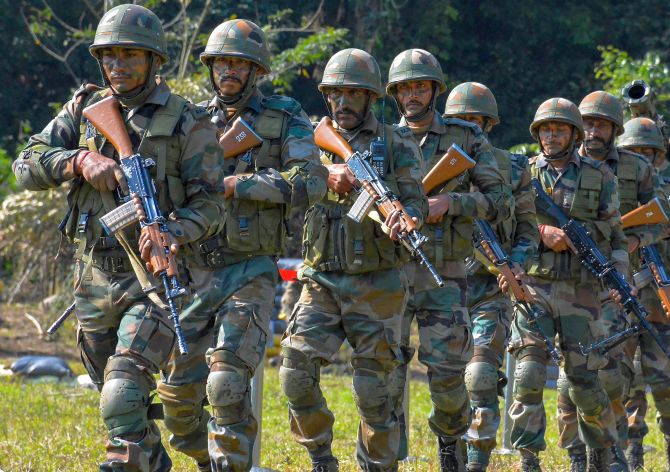For the first time since the 73-day old Doklam stand off last year, Indian Army and Chinese PLA will hold 14-day hand-to-hand drill from December 10 to 24 in Chengdu in China. Each side will send 100 troops to take part in the India-China military exercise, the 7th joint drill between the two Asian rivals. All this is done to change atmospherics between the two countries.
Whether it will happen or not, but on November 13, Indian Defence Secretary Sanjay Mitra and China’s Deputy Chief of Joint Staff Department of Central Military Commission Lt Gen Shao Yuanming held talks in Beijing on issues related to military ties, border control as well as regional and international issues. And just last week National Security Advisor Ajit Doval was in Beijing to hold talks with China’s State Councillor and Foreign Minister Wang Yi on the border dispute between the two countries.
Informal summit between Prime Minister Narendra Modi and Chinese President Xi Jinping in April this year is credited with bringing a thaw in the bilateral engagement of India and China. Chinese Defence Minister Gen Wei Fenghe’s August 21-24 visit injected freshness in so far tenuous relations of the two countries. The Chinese Defence Minister had come with a 25-member delegation. And it was during this visit, the two countries the two sides had agreed to joint military exercise, training and increased armed forces interactions.
Significantly the Chinese Defence Minister’s visit followed two high-profile developments in July-August. Deputy Commander of Chinese PLA’s Western Theatre Command Lt Gen Liu Xiaowu along with 10-member delegation, had arrived in the first week of July in India, while Commander of the Indian Army’s crucial Eastern Command which guards 3,488 km long Sino-border, Lt Gen Abhay Krishna visited China from August 15 to 19. Lt Gen Abhay Krishna had led a four-member delegation and he made a visit to places like Chengdu and Lhasa, besides Beijing and Shanghai. For the first time after the 1962 War, a top military commander of Indian Army and his delegation were allowed to visit the Chengdu Military Area Command which oversees the security of Tibet and the India-China border. In response, India too facilitated Chinese Defence Minister Gen Wei Fenghe with all possible honours during his visit. He became the first Chinese high ranking defence official to address New Delhi-based National Defence College where apart from 58 Brigadiers or Brigadier-level officials of Indian Army, top civil services officials and diplomats from around 25 countries were in attendance. During the Chinese Defence Minister’s visit, the two sides also took up revival of the annual hand-in-hand military exercise which was suspended in 2017. Besides, in the recent past, the two sides witnessed opening of as many as five Border Personnel Meeting points along the LAC—at Bum La and Kibithu in Arunachal Pradesh, Daulat Beg Oldi and Chushul in Ladakh and Nathu La in Sikkim.
These measures were taken to lower temperature between the two sides. Yet the two countries have not lowered their guards. China held three major live-fire drills in the Tibetan region since Doklam stand-off, India has also conducted almost equal number of military drills in North-East and in the Ladakh region where recently troops of 17 Mountain Strike Corps conducted exercise. Indian Air Force conducted largest ever Gagan-Shakti exercise from April 8 to April 22, taking into account two-front wars with China and Pakistan. The exercise was conducted by IAF to test its capability in the radiological, chemical, biological and nuclear attack scenario. While it shows that India is not prepared to take any chances in its deal with China, it is equally intent on improving its relations with Beijing and sort out border differences between the two countries. Yet, it wants to leave no stone unturned to strengthen bilateral engagement with Japan and the US—the two countries with which India has no conflict.
In Buenos Aires, on the sidelines of G-20 summit, Prime Minister Narendra Modi, Japanese Prime Minister Shinzo Abe and American President Donald Trump held their trilateral meeting on November 30. It was the first trilateral meeting among top leaders of the three countries, which share common stand on several issues. Even as it is not known what transpired in that meeting, but it expectedly focused on China’s aggressive agenda in the Indo-Pacific region and strategy to counter it. The US and Japan have been pressurizing India to join regional infrastructure scheme in the Pacific region to give China run for its money on Belt and Road Initiative (BRI). India has so far shown its reluctance to adopt any measure that would rattle its relations with Beijing, which has in the aftermath of its ongoing trade war with the US, has tried to lower its friction with India on trade and border issues. In fact, India wants to balance its relations with the US and China, it sees no merit in clashing with Beijing on almost all issues. Rather under its cooperation-deterrence strategy, India wants to have close cooperation with China on issues which are of their bilateral interests, but ready to flex deterrence wherever it is needed.

















